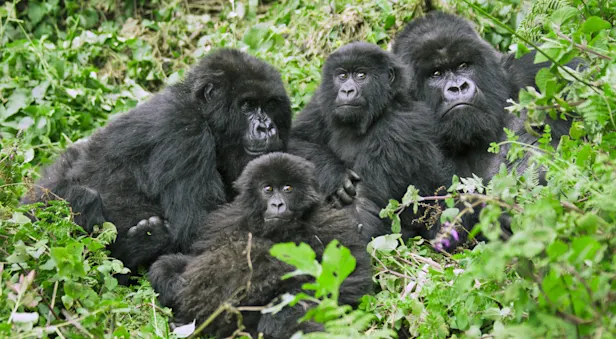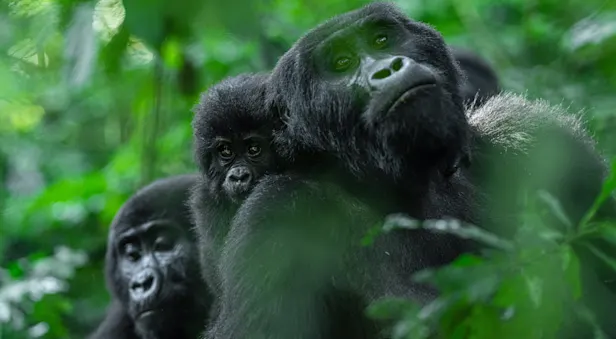
Know Before You Go


Golden Monkey Facts | Uganda & Rwanda Wildlife Guide
Physical Characteristics
The golden monkey is a subspecies of the blue monkey. Along with several other subspecies, the golden monkey was isolated as a result of continuous divisions of forest habitat and subsequently adapted to live in high-altitude forests. The golden monkey is similar to the blue monkey except for its golden-orange backside. Besides this coloration, golden monkeys have black bodies and brown faces. Females are lighter in color than males.
Habitat
The golden monkey resides in the highland forests of Central Africa, which are located in the mountain ranges of Volcanoes National Park in Rwanda, Mgahinga in Uganda and Virunga and Kahuzi-Biéga in the Democratic Republic of the Congo. Golden monkeys prefer habitats with abundant fruit and bamboo in order to accommodate their diet. They typically move between areas depending on the season.
Behavior & Vocalizations
Golden monkeys form groups between 3 and 80 members that are typically presided over by a dominant male. Groups at higher elevations are usually smaller in size. These arboreal primates nest at the top of groves of bamboo, weaving the dense plants together to make a sleeping area for a subgroup of approximately four monkeys. The monkeys forage for food during the day, coming back to one of several sleeping sites each night.
Golden monkeys have a wide range of facial expressions and vocalizations. Males have calls they use during territorial confrontations. Males do not always stay with the group, so sometimes the females take on the task of protecting territories. They have a series of calls to alert others to potential threats, as well as ones that promote unity within the group. Younger monkeys use vocalizations that showcase their submissiveness and to accompany mobbing behavior.
Feeding Habits
These opportunistic feeders primarily eat bamboo, including the leaves, shoots and branches, as well as the ripe fruit. During seasons where ripe fruit is available, they will remain close to the fruit trees. At the start of the rainy season when bamboo shoots begin to grow, they move closer to the bamboo trees. They also incorporate insects (the most common being butterfly pupae), flowers and shrubs into their diet. These primates have cheek pouches in which they store food.
Breeding
Females are in charge of soliciting a mate, though males will mate with multiple partners. Golden monkeys are seasonal breeders, and females give birth once every two years. Gestation lasts five months, and one infant is produced that is born with its eyes open and a coat of hair. Offspring are cared for and nursed by their mothers for up to two years. Males strike out on their own once they become sexually mature, while females generally remain with their natal group for life.
Threats to Survival
This Old World monkey is listed as endangered by the International Union for the Conservation of Nature. Golden monkeys are losing their forest homes due to illegal bamboo cutting and human encroachment, and they are sometimes caught in snares.
Conservation
As the golden monkeys’ habitat becomes increasingly fragmented, conservation efforts are underway to protect this primate. Guided treks into reserves such as Volcanoes National Park generate revenue for this endangered species, and ecotourism in Central Africa is providing incentives to conserve vulnerable species that would otherwise have succumbed to extinction. Researchers in the national parks the monkeys occupy, local community members and scientists from the Dian Fossey Gorilla Fund are collaborating to create a golden monkey conservation action plan. Remote cameras installed in the parks are revealing more about golden monkey ecology and are monitoring illegal human activities as well.
Header Credit: Charles J. Sharp [CC BY-SA 4.0] via Wikimedia Commons

































